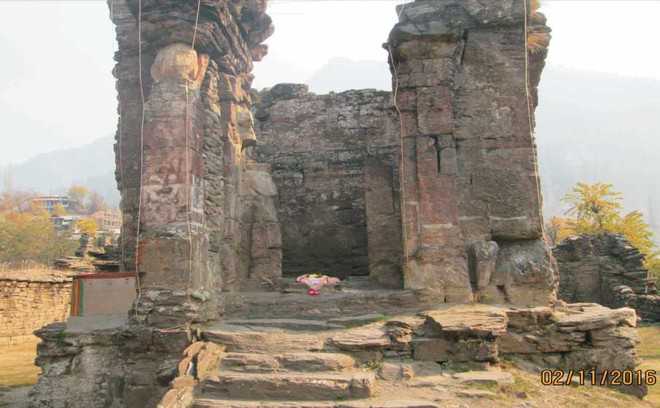Sharda Peeth remains a forgotten shrine in PoK.
Date:- 04 Dec 2018

Sumit Hakhoo
After Kartarpur corridor, demand picks up for pilgrimage to temple revered by Pandits. As the Indian and Pakistan governments recently decided to build the Kartarpur Sahib corridor for Sikh pilgrims, the demand for allowing the pilgrimage to the Sharda Peeth shrine in Pakistan-occupied Kashmir is growing louder in Jammu and Kashmir. From mainstream political parties to displaced Kashmiri Pandits, everyone has kept their fingers crossed when the two countries would take the decision to allow pilgrims to visit the shrine, abandoned for the last 71 years after Pakistan invaded and occupied a part of the state in the 1947 war.Peoples Democratic Party president Mehbooba Mufti has already written to Prime Minister Narendra Modi while National Conference patron Farooq Abdullah has pitched for the opening of all traditional routes with Pakistan and PoK from J&K.
Historians say the Sharda Peeth temple has great significance for Hindus and was a spiritual and religious centre and an Important learning centre
“Kashmir in ancient times was called Sharda Desh and was one of the important learning centres for Hindus and Buddhists. Scholars from across the Indian subcontinent used to come to the shrine and take advise from religious scholars to verify the texts written by them,” said Padma Shri Ved Kumari Ghai, one of the eminent Sanskrit scholars in the country.Ghai has translated Nilamata Purana, an ancient text from Kashmiri into English. Nilamata contains information on history, religion and folklore. “If the pilgrimage is allowed, it will be a historic event,” she said.
The shrine is also linked to Adi Shankara, an 8th century philosopher and theologian who consolidated the doctrine of Advaita Vedanta.Ramesh Tamiri, a researcher on Kashmiri history and culture, said Adi Shankara had visited the place and engaged in a discourse with scholars.
“It was at Sharda that he wrote the beautiful Saundarya Lahiri, in which he expounds the concept of Sri Chakra. The shrine also has a link with Saraswat Brahmins who once lived along the Saraswati river. Pandits also trace their ancestry to that civilisation,” says Tamiri.The temple is not exclusive to Pandits. There are several shrines linked to Sharda across the subcontinent after people living along the Saraswati migrated to other regions when the great river has dried.
Shrine in ruins
The Sharda temple is surrounded by snow-capped Himalayas and dense forests. From the shrine is visible a panoramic view of the Neelam valley, now under the occupation of Pakistan. The gateway to the shrine is through a staircase which has two flanking walls. Around 64 big steps and nearly 200 small steps lead to the shrine. The temple was severely damaged in the October 8, 2005, earthquake and is in a dilapidated condition.
“As per the information provided by activists in PoK, the Deputy Commissioner of Neelam has said that 70 kanals belongs to the shrine. But its revenue documents are in J&K. We have started efforts to reach out to the revenue officials in the state,” said Ravinder Pandita, founder member, Save Sharda Committee.
Demand for LoC bus service
Since the opening of the bus service between the two divided parts of J&K in 2005, Kashmiri Pandits have been demanding that they be allowed to use the service. However, only those who have relatives on either side can use the bus service. The Supreme Court of PoK on a letter sent by the Save Sharda Committee in 2017 had issued directions to the ‘PoK government’ to take steps to protect the abandoned temple and also trace other temples and gurdwaras to put them on the heritage list for preservation.
In 2013, Vinod Pandita, chairman, All Party Migrant Coordination Committee, had started a hunger strike in Porbandar, Gujarat, over the issue. “Both countries should allow Hindus and Sikhs to use the cross-LoC bus service to visit the shrines in PoK,” said Pandita. In January 2016, a group of social activists in PoK had visited the temple and sent pictures and videos allowing people to have a glimpse of the shrine in decades.
Flourished during Dogra rule. According to historians, the Sharda Peeth temple was a spiritual and religious centre and Goddess Sharda was the presiding deity of Kashmir Mandala in ancient times. It has great significance for Hindus
The Sharda temple on the banks of the Kishenganga (Neelam) at Sardi village in Pakistan-occupied Kashmir was one of the 18 Shakti Peeths across the Indian subcontinent and was associated with the goddess worship in Kashmir since ages. It is situated across Kupwara district
The temple flourished during the Dogra rule under Maharaja Gulab Singh and Maharaja Ranbir Singh. Till 1947, pilgrims would visit the temple on special occasions
Courtesy: Tribune: 4th Dec, 2018


